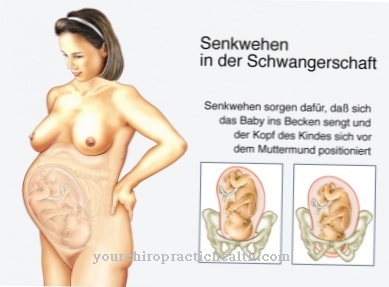Mitosis takes place in several phases. The Prophase the beginning of mitosis. Disturbances in the prophase prevent the initiation of cell division.
What is the prophase?
Both mitosis and meiosis begin with a prophase. Cell division occurs in both cases. However, while in mitosis the identical genetic material is passed on to the daughter cells, in meiosis the formation of germ cells takes place while the genetic information is halved.However, just like normal body cells, the germ cells produced during meiosis can continue to divide via mitosis.
The actual mitosis does not include cell division but is characterized by the process of increasing the identical genetic information with the formation of new cell nuclei. Usually, however, the cell division of the entire cell is linked to this. In a few cases, however, mitosis takes place without further cell division (cytokinesis). Then multinucleated cells are formed which, among other things, perform various functions in the formation of new cells in the blood-forming system.
The course of mitosis is divided into prophase, prometaphase, metaphase, anaphase and telophase. The prophase always serves to initiate mitosis. Often the prometa phase is counted as a prophase, since the processes of both sub-phases run in parallel.
Function & task
The prophase follows on from the so-called interphase, in which an identical copy of a chromatid is replicated and this is linked to the identical sister chromatid via the centromere. At the end of the interphase, mitosis is prepared. In this phase the chromatin is loosely packed and appears thread-like. The interphase thus represents the phase between two cell divisions and does not belong to mitosis.
The actual mitosis then begins with the prophase, in which the chromatin increasingly condenses through folds. Visible structures can now be discovered in the light microscope. These more compact structures make the chromatin transportable, so that the prerequisites for the division of the identical chromatids into the gradually emerging cell poles are created. In this phase, the chromosomes consist of two identical chromatids that are held together at least at one point of constriction, which is also known as the centromere. There is a longitudinal gap between the two identical chromosome chromatids. In this compact form, the chromatin can be transported, but no longer read. Therefore, no new proteins are formed during this phase. The nucleoli (nuclear bodies) required for this dissolve.
At the same time, division creates two centrosomes, each of which is positioned on the opposite side of the nucleus and there begins to develop its spindle apparatus. The spindles consist of microtubules that are built up from tubulin subunits through polymerization.
During the further phases of mitosis, these spindle fibers must make contact with the centromere of the chromosomes in order to dissolve it and to draw the two identical chromatids to the respective poles. In order for the spindle fibers to get there, the nuclear envelope must first be temporarily broken down. The nuclear envelope consists of lamines. These are dissolved through the process of phosphorylation. This happens during the prometa phase, which is partly part of the prophase and partly viewed as a separate phase.
At the centromeres there are protein structures known as kinetochores to which the spindle fibers can dock. This creates kinetochore microtubule structures that are arranged parallel to the pole fibers and are responsible for the later transport of the separated chromatids to the poles. During this phase, the spindle apparatus completes itself as the star fibers emanating from the centrosomes make contact with the other components of the cytoskeleton. The build-up of these structures causes the centrosomes to move further and further in the direction of the cell poles.
In the metaphase that follows the prometaphase, the chromosomes are centered. In the subsequent anaphase, the identical chromatids are separated at the centromeres. The last phase (telophase) begins with the arrival of the chromatids at the poles and ends with the decondensation of the chromosomes.
Illnesses & ailments
Cell divisions take place in both unicellular and multicellular organisms. In humans, animals and plants, mitosis is the prerequisite for the growth and general functionality of the organism. Old cells die and have to be constantly renewed. In the context of mitosis, however, it can happen that no completely identical copies of the genetic material are passed on. These are so-called mutations that can influence the functionality of the newly created cells. Serious illnesses can result. Cancer also arises as a result of deregulation of cell division through genetic changes or hormonal malfunctions.
However, genetic changes mainly occur between the individual mitoses in the interphase or in the anaphase with incorrect separation of the chromatids. The occurrence of mutations is not possible in the prophase itself, since here only structural changes occur through compression of the chromosomes.
However, disruptions during prophase are always fatal because they prevent the initiation of mitosis. Cell divisions could no longer take place. Old cells would simply die and would no longer be replaced by new cells. There are also no known congenital diseases based on a disorder of the prophase during mitosis.













.jpg)

.jpg)
.jpg)











.jpg)